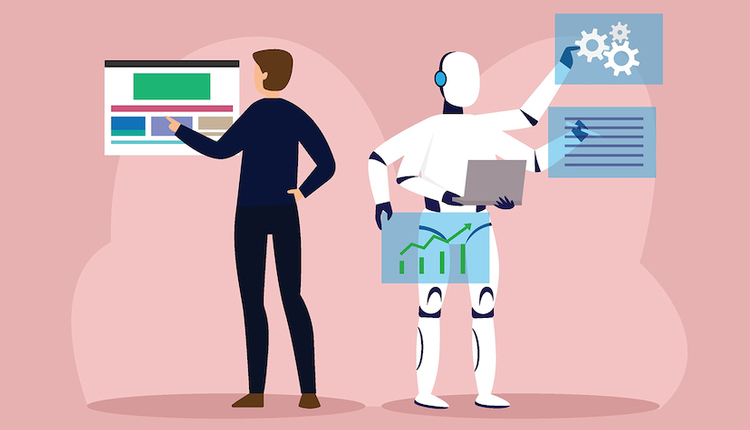
Let’s start by talking about the unicorn. The unicorn is the combination of AI, IC, task automation with RPA and workflow to create intelligent process automation (IPA) that’s really worthy of the name. One of our clients, a senior IT architect who’s working with these technologies, declared a few years ago in conversation that combining these technologies would be capturing the unicorn.
Until recently, intelligent process automation was a joke: most of the tools weren’t very intelligent, they addressed tasks, not processes, and they automated little because they had limited application and required human assistance. That’s changed and today intelligent process automation is truly possible: RPA automates tasks; intelligent capture digitizes content to feed RPA; AI makes both RPA and intelligent capture smarter; and next-gen process automation orchestrates and manages all the pieces in the process.
Intelligent Capture Understands Document Data
Intelligent capture (IC) software is used to capture the information on documents, categorize those documents and pages and extract relevant data for further processing using AI with technologies such as OCR, NLP, computer vision and machine/deep learning. The primary capabilities for IC are:
- Classification is automatically identifying what pages, what documents and what document packages the system is getting.
- Extraction is recognizing the data that’s on the pages, and I’ll include possibly enriching it (e.g., by judging sentiment or how angry the customer is given the letter they just wrote you).
- Validation and QA is checking for completeness and correctness of the information and document sets.
- Finally, conversion and export is transforming the data into whatever standard format the downstream systems and people need – e.g., converting customer name into ALL CAPS with NO SPACES or PUNCTUATION.
The results are much better than what you got from the older 1990s OCR tools. First, the new tools are better in how they recognize the text — in how they classify docs, paginate pages and extract documents. In a sense, they have changed from how young children read to how adults read. Young children focus on letters, then words, in a slow process. Adults use more context, including existing knowledge, the overall document and page layout and look, what the document’s probably about, etc. The new tools may use computer vision, pattern analysis and other methods to take advantage of more context.
Second, the new tools are better in how they improve that recognition — in how they continuously improve the accuracy of their opinion in light of evidence. The learning capabilities range from moderately intelligent to brilliant. They range from the case where a human “supervisor” must do everything (e.g., drawing bigger zones in the template), to where the system can brilliantly improve its recognition accuracy by itself.
Robotic Process Automation Tools Automate Tasks
A natural place to start digital transformation using intelligent automation is with RPA. RPA tools automate steps of a process by mimicking the manual steps a human worker would take when using existing application software.
It’s been highly successful in back-office clerk activities in financial services and insurance, call center and typical swivel chair activities. Examples include document and data download, transaction processing; data entry in high- volume, repeatable, and computer-centric processes; double and concurrent data entry into old and new systems during migrations.
RPA is quickly maturing, and best used for repetitive and rule-based tasks. It’s a significantly more sophisticated evolution from macros and scripts. It’s often deployed tactically — as standalone duct tape repair — or more strategically with BPM or case management tools that manage entire processes. So now it should be clear where RPAs are a traditional good and bad fit — and where they are helped by AI and IC. They historically work well with processes that are rule-based, simple or moderately complex, stable, mature and documented. If AI makes them smarter they can do better with less structure and more complexity. They also historically required that the processes be digital with structured data — and many processes otherwise suitable for automation do not have neatly structured data inputs, making them inaccessible to RPA solutions. But if you attach IC to the front end you now can address the processes that include paper and dumb images.
Digital Automation Platforms Manage All the Pieces
That leaves workflow or process management — where does that fit in? Well, next-gen workflow emerged from past and current generation process management approaches, including simple work routing, document-centric workflow, business process management and case management. These platforms aspire to include most of the capabilities of the preceding types and are “low code” – they are lightweight and can be configured by “citizen developers.”
Digital automation platforms’ most important contribution to the unicorn is in orchestrating, coordinating and managing the various IC and RPA pieces you have — so you have a much more efficient, stable automated process.
The Unicorn’s Been Captured
This combined-tool approach was envisioned five or so years ago. The job now is to make it actually work in production environments. What’s happening now is primarily the execution and maturation of the solutions. There are a few emerging capabilities that will again revolutionize intelligent process automation – and they’ll be described in a moment. But first let’s look at the incremental improvements:
- More of the IC solutions are correcting an early oversite and are driving document scanners and other capture devices. This means that you don’t have to create even more of a Frankenstein monster with multiple vendors.
- Both vendors and organizations are applying IPA to collaboration scenarios in addition to more structured transactional processes.
- The vendors are applying and orchestrating multiple understanding engines in intelligent capture, to address a broader and more difficult range of document types and recognition problems. Earlier solutions often used only one or a few engines.
- More of the solutions are applying pre- and post-processing to improve the usefulness of the output.
- Some of the solutions participate in online marketplaces and other communities to share specialized apps and reusable training databases for the specialized document types and scenarios in specific vertical industries.
But There Are Two Revolutionary Advances
Into this maturing set of IPA capabilities behaving decently under the management of a process automation platform, we see two revolutionary advances.
- Extending Intelligent Capture to include rich media and human interactions
- Extending Process Mining to include processes, tasks, documents and rich media
Both are dramatic because so much of our processes is interaction-based and may require understanding and acting on rich media.
Extending Intelligent Capture to Rich Media
AI-based interaction understanding and automation is the application of intelligent capture not to documents but to rich media — video, audio and images. It applies AI-based classification, extraction, validation, enrichment and transformation to video, audio and images — which means any collaboration or interaction scenario. It will have dramatic impact on all interaction and collaboration scenarios, which include:
- Financial services, utilities and many other verticals have an ingestion process that includes mail, email and fax — but also phone, walk-up and more personal meetings, some with collaboration.
- Insurance claims processing includes several interviews.
- Banking interactions range from simple transactions to more complex regulated ones like changing account owners or their information.
- Across the board in call center.
- Collaborative or advisory meetings between agents and investors, in contract negotiations, or in internal meetings.
- Sire-type scenarios involving automated collaboration partners.
In all of these scenarios the rich media can be combined with information from all the other channels (documents, data) in the workflow, combined with RPAs to execute tasks, and stored for business and compliance purposes.
Extending Process Mining to Rich Media
The second innovation involves combining process mining and rich media. Let’s first explain process mining. Process mining software is designed to analyze event logs and other data from processes in order to identify process improvement and automation opportunities. For content-centric processes in particular, the new process mining tools can be invaluable in helping you analyze, optimize, migrate and monitor them.
Process mining is hot today. The field of solutions is rapidly growing, with both product expansion and consolidation. IBM just bought process mining vendor myInvenio. Currently the top vendor, Celonis, owns more than 60% market share. Others include Software AG, ABBYY, UiPath and many others.
Process mining traditionally has worked well where most of the process is under the control of one or a few business systems or workflow systems — like a banking system, a claims system like Guidewire, an ERP system like SAP or a workflow system like Pega. But many processes include desktop work, lots of documents and of course interactions and collaboration. So to be highly effective, process mining should include “task mining,” “document mining,” and “media mining:”
- Task mining extracts the user activity data associated with desktop tasks, the swivel chair work that might be done with Office 365 tools like Excel or Word or PowerPoint or other tools. This is often a substantial fraction of the work done in e.g., advisor meetings, or in the front and middle office in financial services. Celonis, IBM/myInvenio and UIPath are some of the vendors providing task mining today.
- Document mining extracts the information in documents. IC can extract all this data and get it quickly into the workflow with proper routing and automated tasks. But now you can optimize those processes just like you can optimize ERP. ABBYY and Kofax are two vendors who provide some form of document mining today.
- Media mining extracts the information in communications, interactions, video, audio, images and other rich media. So much information is in these interactions and rich media — and human interactions are a major source of opaque inefficiencies. Veritone offers some media mining capabilities today.
AI-Based Media Capture and Media Mining Have Two Kinds of Impacts on Your Processes
To summarize, the advances in AI-based interaction automation and process mining will have two dramatic impacts on your processes:
- In-process execution: They allow organizations to automating the understanding of all work and collaboration channels, particularly those involving interactions and rich media; then automating tasks that use that information. An example is recognizing customer information and what e-forms are needed for onboarding in banking and then presenting the pre-filled and validated forms for e-signature.
- Process optimization: They allow organizations to mine interaction data and combine it with document, task, and process mining to improve those processes.
Interested? Do a Proof of Concept
In the last few years most of our clients and their peers have conducted IPA proofs of concept (POCs) as a first step, usually IC tools by themselves or combined with the other pieces as some form of unicorn. We strongly recommend that you do a POC of these tools in your environment if you are thinking about them.











